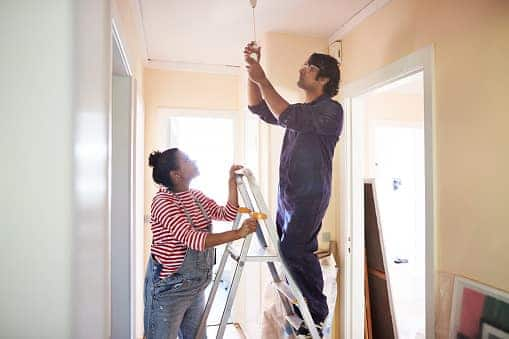Why are so many homes underinsured?
Keith Balsiger, president of Balsiger Insurance in Reno, Nevada, says rising construction costs is one reason why so many homeowners become underinsured. Inflation causes construction costs to go up, but insurance policies don't always keep up.
Carole Walker, executive director at Rocky Mountain Insurance Information Association in Greenwood Village, Colorado, says one way to make sure your home is insured properly is to make sure you understand what replacement cost means. "That's not the market value, but the cost to rebuild in today's dollars -- your insurance company doesn't have an investment in what you can sell it for, but rather current repair and rebuilding costs," Walker says.
Few people know that insurance companies have an 80% rule for replacement cost insurance. You must insure your home for at least 80% of it's replacement cost in order for claims to be covered in full. If you don't, the insurance company will reduce your claim payment based on how underinsured you are.
And if your home is totally destroyed and you're underinsured, there won't be enough to rebuild it.
How to make sure your home isn't underinsured
The most common mistake homeowners make is not reviewing their home insurance policy each year. Here are some things to look for and remember to make sure you have the right amount of insurance.
Don't buy the minimum coverage
If you have a mortgage, your lender will require you have a certain minimum amount of homeowners insurance coverage. Depending on the terms of your financial contract that amount may be the same as the unpaid mortgage balance or a higher amount that would be enough to cover replacement costs of the home. Remember that neither the loan balance nor the market value represent the actual replacement cost of your home. Your coverage should always reflect the replacement cost.
The minimum liability protection you can get is usually $100,000, but experts recommend three times that. That means home insurance coverage equal to your mortgage balance with minimum liability limits is often not enough to fully protect you.
Skimping on coverage isn't worth it. You could save $50 or $100 by cutting your coverage, but your home is your largest investment and asset. It's wiser to look for other ways to save. For instance, consider raising your home insurance deductible. An Insurance.com rate analysis found that by jumping from a $500 deductible to $2,500, the average savings is $260, though in some states you can save more than twice that much. You can also bundle your home and auto policies with the same company. Bundling is one of the biggest home insurance discounts you can get, saving on average about 19% a year.
Notify your insurer and update your policy if you do home renovations or add features
Improving your home adds to its value, but can also mean you become underinsured. So, it's important to notify your insurer when you improve your house and increase coverage to protect your home adequately.
A recent survey by Nationwide Insurance, a top insurance company, found that 55% of homeowners who did a major renovation in the past two years did not report it to their insurance company. That leaves those homes underinsured.
Even if you don't renovate or remodel, but add a deck, pool, trampoline or woodstove to your property, you should tell your insurance company. Failing to do so could mean your policy won't pay out for damages or injuries from such new features.
Check your other structures coverage
Coverage B, or Other Structures, on your policy is the portion that will cover any structure that's not attached to the house. It's calculated as 10% of the dwelling coverage. So, if you have $200,000 in dwelling coverage, your other structures coverage is $20,000. the ZestyAI study found 31% of homes have two structures, 11% have three structures and 4% have three or more. Your insurance company may not be aware of the presence of these structures, especially if you live on an acreage.
Even if you have enough replacement cost coverage for the home, your other structures coverage may not be enough if you have multiple structures, or if one of those structures is furnished, like a pool house. Increase your other structures coverage to protect all of the buildings on your property.
Update your personal property inventory
Make sure you adequately cover your personal items, and that the inventory of what’s inside your house is current.
The contents of your house are protected under the personal property coverage part of your policy. Coverage limits are set as a percentage of dwelling coverage, usually 50% to 70%.
Personal possessions that are worth a lot, such as jewelry, art, antiques, guns and coin collections, are usually limited to $2,500 worth of coverage. If your items’ worth exceed this amount, it’s wise to purchase extra coverage, called a rider or endorsement, up to the limit on these types of items. You'll need to provide receipts and appraisals to document replacement costs.
"Document your personal belongings by creating a home inventory with photos and receipts. Most insurance programs provide downloadable home inventory apps that make the process easier and will help take the headaches and heartaches out of the claims settlement process," Walker says.
Assess your exclusions and endorsements
You should also review your exclusions and endorsements, the parts of your policy that give or take away coverage. Endorsements can ensure you are fully protected and are typically very affordable. Reviewing your exclusions will help you determine how to protect your home from severe weather and if you need to buy more liability insurance.
Endorsements
You can get an endorsement for expensive personal possessions, as explained above, but there other important ones you should know about.
Sewer and sump-pump backup: Adding sewer and drain backup coverage to your homeowners policy is wise. It is one of the most common homeowners claims, averaging $10,000-$20,000 in expenses, and it is almost always excluded from a basic policy.
Special personal property coverage: You can add additional coverage for damage to your personal property that is generally not covered by a standard policy, such as from a power surge.
Home-based business: If you have just a simple home office, you can typically get a home-based business endorsement to cover your office equipment and related property. But if you have a daycare, dog grooming or other type of full-fledged operation, you will need a separate commercial business property to ensure full coverage.
Exclusions
Dog breeds: Typically a home insurance policy's liability coverage has included dogs. But a growing number of home insurers now exclude "dangerous" breeds from liability coverage due to the increasing amount – and cost – of dog bite claims. Others require dog owners to sign liability waivers for dog bites. If you have a dog, be sure to check your policy to see if it is excluded from liability coverage or not.
Some insurers, including Liberty Mutual, Nationwide and Amica, don't discriminate based on breed and evaluate your dog based on its history and behavior. Also, some states, such as Maryland, Pennsylvania and Michigan, don’t allow insurance companies to deny coverage to owners based on a specific breed of dog. However, that doesn't prevent insurance companies from charging higher premiums, so some dog owners may still have difficulty getting coverage.
Wind and hail (some states): Damage from wind and hail is covered under standard policies in some states, but in some others, it is not. Insurers in states where hurricanes and tornadoes are common sometimes put wind and hail exclusions in home policies. That means damage isn’t covered unless you buy separate wind and hail coverage. There are also exclusions for cosmetic roof damage from hail, which means if the roof is structurally damaged, you can file a claim, but if it is dinged up, you can’t. Be sure to check your policy for wind and hail exclusions to be sure you’re sufficiently covered.
Floods and earthquakes. Both floods and earthquakes are excluded from homeowners insurance. You will need an endorsement or a separate policy to get this coverage.
Flood insurance is sold as a separate policy, while earthquake coverage is usually an endorsement,
Buying replacement cost coverage
Replacement coverage for your home and personal belongings help make sure you can properly repair and rebuild your home -- and replace items damaged, destroyed or stolen.
Make sure that you review it regularly to keep up with inflation. "While most policies have a built-in inflation guard it is very likely that it has not kept pace with the increasing cost to build," Balsiger says.
A few years ago, builders sold new homes for under $100 per square foot. Those same new homes sell for $150 per square foot or higher, he says.
"This means that the cost to rebuild is now 50% higher. One way to do a self-check is to research what new homes are selling that are similar to yours. Compare it to the coverage you have to see if you are properly insured. Keep in mind that a rebuild is usually more costly than brand new construction. This is due to clean up/teardown of the site," Balsiger says.
You can also choose extended or guaranteed replacement cost as endorsements on your policy. These add additional protection in case the calcualted amount falls short.
Buying liability coverage
Home insurance covers you if you, a family member living with you or even your dog is to blame for injuries or property damage. Many people are underinsured in this crucial area as well.
Personal liability coverage helps with property damage, medical bills, pain and suffering and lost wages. This type of coverage can also cover you for death benefits and legal costs.
"We live in a litigious society and you need to consider what could be at stake if you had a claim or lawsuit filed against you when someone is injured on your property or if you, a family member of a pet is responsible for hurting someone or causing damage to someone else's property," Walker says.
Liability limits go from $100,000 up to $500,000, with $300,000 the recommended amount to ensure sufficient coverage. If your assets exceed $500,000 you may want a separate umbrella policy. Umbrella insurance protects you up to $5 million depending on your policy.
Sources:
ZestyAI. "Hidden in Plain Sight: A New Era of Risk Assessment Accounts for Multi-Structure Properties." Accessed December 2024.
Nationwide. "Survey shows uptick in home renovation projects, but insurance coverage still lags." Accessed December 2024.
Kin Insurance. "Report: How many U.S. homes are underinsured?" Accessed December 2024
FAQs
Can I insure my home for less than the replacement cost?
Yes, you can insure your home for less than the replacement cost, but it's not recommended. If you do, you might not have enough coverage to rebuild your home fully if it's destroyed. It's best to insure your home for its full replacement cost to ensure you're fully protected.






